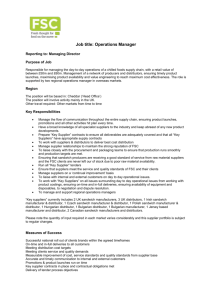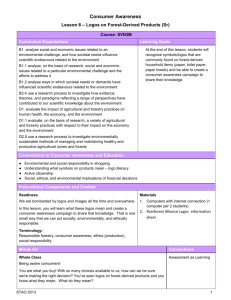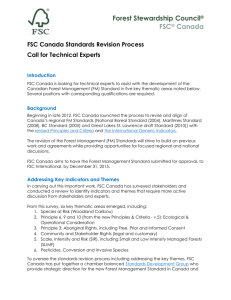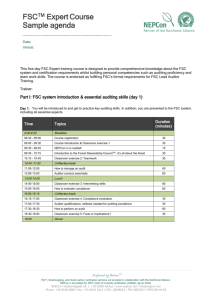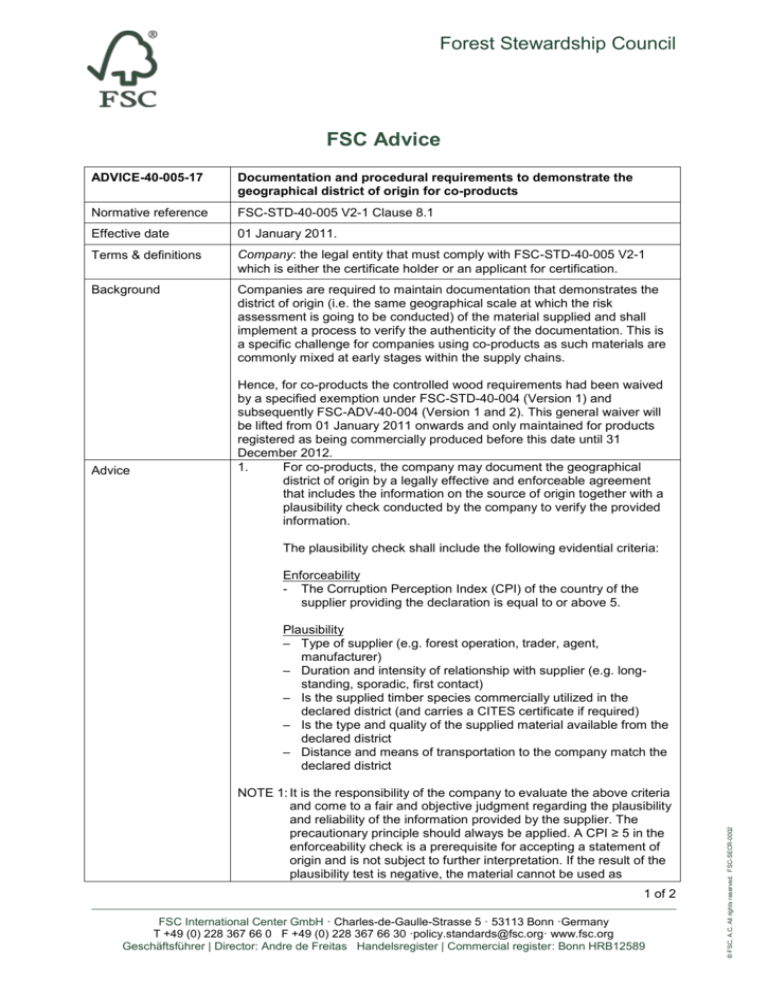
Forest Stewardship Council
FSC Advice
ADVICE-40-005-17
Documentation and procedural requirements to demonstrate the
geographical district of origin for co-products
Normative reference
FSC-STD-40-005 V2-1 Clause 8.1
Effective date
01 January 2011.
Terms & definitions
Company: the legal entity that must comply with FSC-STD-40-005 V2-1
which is either the certificate holder or an applicant for certification.
Background
Companies are required to maintain documentation that demonstrates the
district of origin (i.e. the same geographical scale at which the risk
assessment is going to be conducted) of the material supplied and shall
implement a process to verify the authenticity of the documentation. This is
a specific challenge for companies using co-products as such materials are
commonly mixed at early stages within the supply chains.
Advice
Hence, for co-products the controlled wood requirements had been waived
by a specified exemption under FSC-STD-40-004 (Version 1) and
subsequently FSC-ADV-40-004 (Version 1 and 2). This general waiver will
be lifted from 01 January 2011 onwards and only maintained for products
registered as being commercially produced before this date until 31
December 2012.
1.
For co-products, the company may document the geographical
district of origin by a legally effective and enforceable agreement
that includes the information on the source of origin together with a
plausibility check conducted by the company to verify the provided
information.
The plausibility check shall include the following evidential criteria:
Enforceability
- The Corruption Perception Index (CPI) of the country of the
supplier providing the declaration is equal to or above 5.
NOTE 1: It is the responsibility of the company to evaluate the above criteria
and come to a fair and objective judgment regarding the plausibility
and reliability of the information provided by the supplier. The
precautionary principle should always be applied. A CPI ≥ 5 in the
enforceability check is a prerequisite for accepting a statement of
origin and is not subject to further interpretation. If the result of the
plausibility test is negative, the material cannot be used as
1 of 2
FSC International Center GmbH · Charles-de-Gaulle-Strasse 5 · 53113 Bonn ·Germany
T +49 (0) 228 367 66 0 F +49 (0) 228 367 66 30 ·policy.standards@fsc.org· www.fsc.org
Geschäftsführer | Director: Andre de Freitas Handelsregister | Commercial register: Bonn HRB12589
® FSC, A.C. All rights reserved. FSC-SECR-0002
Plausibility
– Type of supplier (e.g. forest operation, trader, agent,
manufacturer)
– Duration and intensity of relationship with supplier (e.g. longstanding, sporadic, first contact)
– Is the supplied timber species commercially utilized in the
declared district (and carries a CITES certificate if required)
– Is the type and quality of the supplied material available from the
declared district
– Distance and means of transportation to the company match the
declared district
© 2007-2010 Forest Stewardship Council A.C. All rights reserved.
controlled material input.
NOTE 2: The supplier statement of origin is not intended to replace the
company's responsibility for conducting a full risk assessment. The
statement shall only provide the basis for the risk assessment, i.e.
the information on the geographical origin of the raw material,
according to Clause 8.1 of FSC-STD-40-005 V2-1.
2
The agreement shall be in writing and shall include:
a) The information on the geographical origin (e.g. country, region,
forest management unit) of the supplied co-product which is
necessary information for the company’s risk assessment. The
type of information provided must match with the geographical
scale of the risk assessment.
b) A commitment that, in a case where the material is considered
as originating from areas with unspecified risk, the supplier will
support the company to get information to identify the forest of
origin and the whole supply chain relating to that supply.
3.
Certification Bodies shall confirm that adequate documentation is
maintained and verified each time they evaluate the company's risk
assessments.
2 of 2




